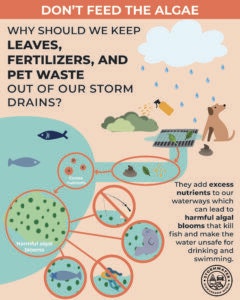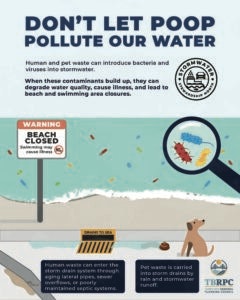From Street to Stream

Bay Soundings: Tampa Bay's Environmental News
May 2025
Stormwater runoff is the largest single source of pollution in Tampa Bay – but it’s also the place where each of us can make a difference. The Tampa Bay Regional Planning Council (TBRPC), in collaboration with UF/IFAS and local governments across the region, created Stormwater Stewardship Month, a month-long education campaign to raise awareness about stormwater runoff and how residents can impact water pollution in lakes, rivers and the bay.
“Stormwater is simply rain that runs off streets, lawns, and other surfaces, and it picks up everything in its path before flowing into the storm drain system and out into nearby waterways,” said Mesly Mata, the Gulf Research Program Fellow coordinating the campaign for the TBRPC. “Most people don’t realize that stormwater isn’t typically treated so whatever it picks up in your yard or off your driveway, including pollutants like excess fertilizer, petroleum products, animal waste and trash, is likely to end up in our streams, lakes, rivers, bays or the gulf.”
Even minor showers produce stormwater – just an inch of rain across an acre of land generates 27,154 gallons of water, Mata said. When it lands on impermeable surfaces in our neighborhoods, all that water doesn’t have a chance to be absorbed into the ground, so our waterways receive large amounts of pollutants.

When pollutants like fertilizers and animal waste end up in the bay, they contribute to algal blooms, which block sunlight from reaching the bay bottom where seagrasses need it to survive. Seagrass meadows are considered to be some of the most productive ecosystems on earth and are critical to the survival of hundreds, if not thousands, of species small and large. For instance, hundreds of manatees died of starvation when nutrient-fueled algal blooms wiped out the seagrasses in the Indian River Lagoon between 2021 to 2022. More recent research shows that dolphins also died of starvation when algal blooms killed off seagrasses.
Stormwater pollutants can come from a wide variety of sources including:
- Pet waste can carry diseases like salmonella, giardia, toxocariasis, and toxoplasmosis, along with high concentrations of nutrients that cause algal blooms. A single gram of pet waste contains an average of 23 million fecal coliform bacteria, some of which can cause disease in humans.
- If applied in excess or prior to rainfall, fertilizer can be washed off your property to nearby water bodies, stimulating excessive plant and algae growth. While most cities and counties limit the use of fertilizer during the summer rainy season, pesticides and herbicides are also toxic to aquatic life and ecosystems. You should minimize their use or consider using a safe biopesticide like neem.
- Leaves and grass clippings are loaded with nutrients, and they can clog storm drains and cause local flooding. High levels of nitrogen yard waste can also boost the number of mosquitoes – up to a nine-fold increase in production – in wetlands.
- Even swimming pool water can release harmful chemicals that impact water quality. Experts recommend dechlorinating your pool by not adding chemicals for a few days before draining.
- Construction sites can release high levels of sediments, which cloud water and often carry other pollutants. Every construction site should have an approved inspector to ensure that appropriate practices are in place.

“Most people don’t fully understand the connection between what happens in their yards and driveways and pollution in our waterways, so education is critical to change,” Mata said. “By educating residents about the sources, consequences and solutions to stormwater pollution, we can all make a difference, which is the primary goal of Stormwater Stewardship Month.”
The first week focuses on defining stormwater and the path of stormwater runoff, the second week aims to highlight the impacts of stormwater runoff on natural areas and habitats, and the third and fourth weeks dive into common sources of stormwater pollution and solutions. The team creating Stormwater Stewardship Month has developed cohesive messaging and free graphics, available in multiple file formats, that anyone can download and share.

Mata recommends starting with the Stormwater Stewardship Pledge, which focuses on actions residents can take to prevent stormwater pollution. Numerous other resources, including stormwater bingo, local podcasts, student worksheets and webinars are available at tbrpc.org/stormwaterstewardship. Local governments can take part in the events with a proclamation template that declares May as Stormwater Stewardship Month. “So far, Pinellas County and the City of Seminole have passed the proclamation for May 2025, and more are expected to join next year,” she said.
Multiple events are planned across the region including:
Tuesday, May 6, A Walk in the Watershed, 1-2 pm, John Chesnut Park
Wednesday, May 7, “Walk” the Watershed webinar, 12:15-1 pm, online
Thursday, May 8, Walk the Watershed, 9:30, Lake Seminole Park
Saturday, May 17, Beach Cleanup at Gandy Beach with Keep Pinellas Beautiful, 9 am
Tuesday, May 20, “Walk” the Watershed webinar, 12:15-1 pm, online
Friday, May 23, Family Fun Friday, Watershed Exploration at Brooker Creek Preserve
